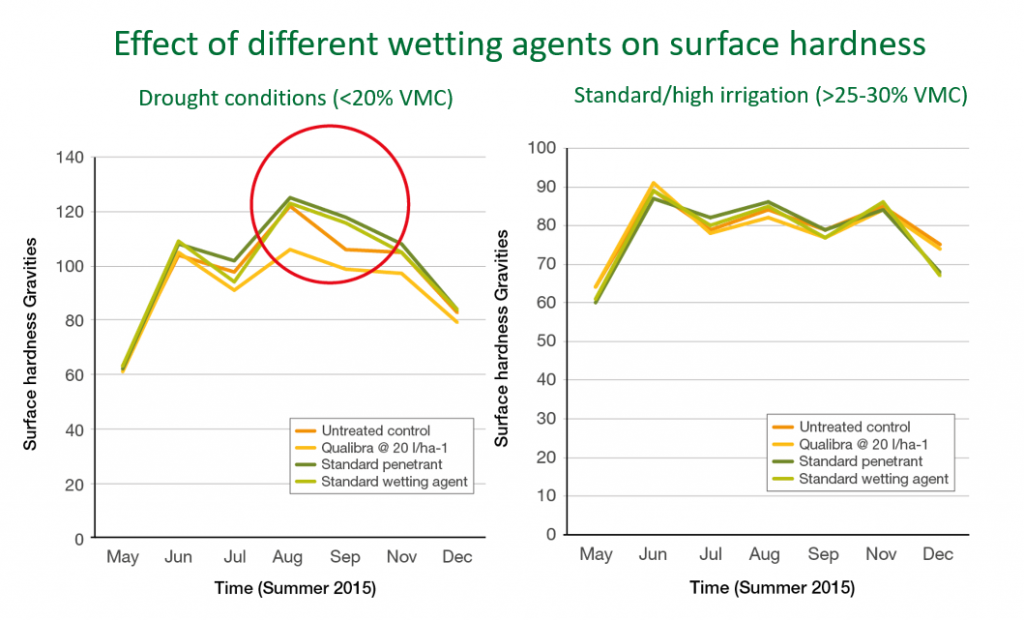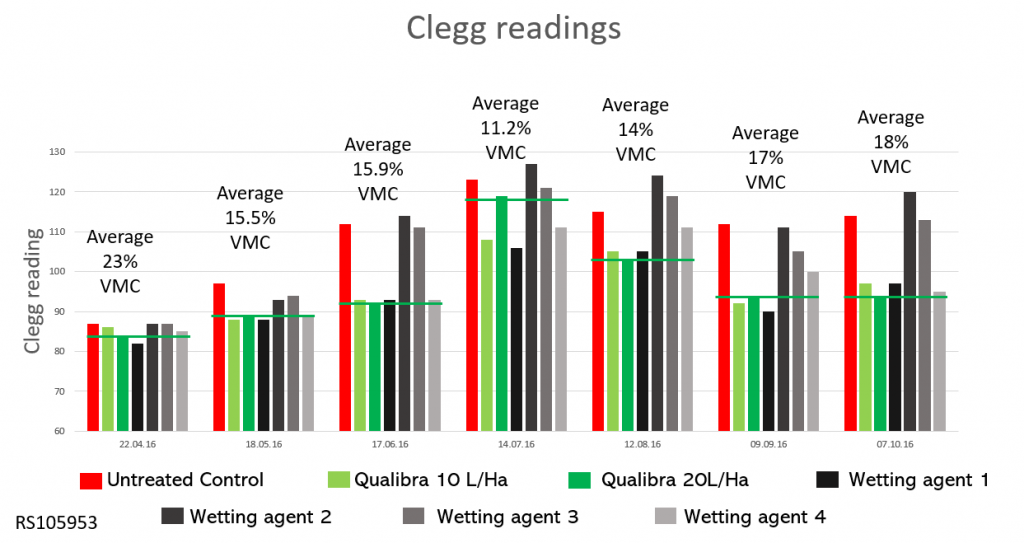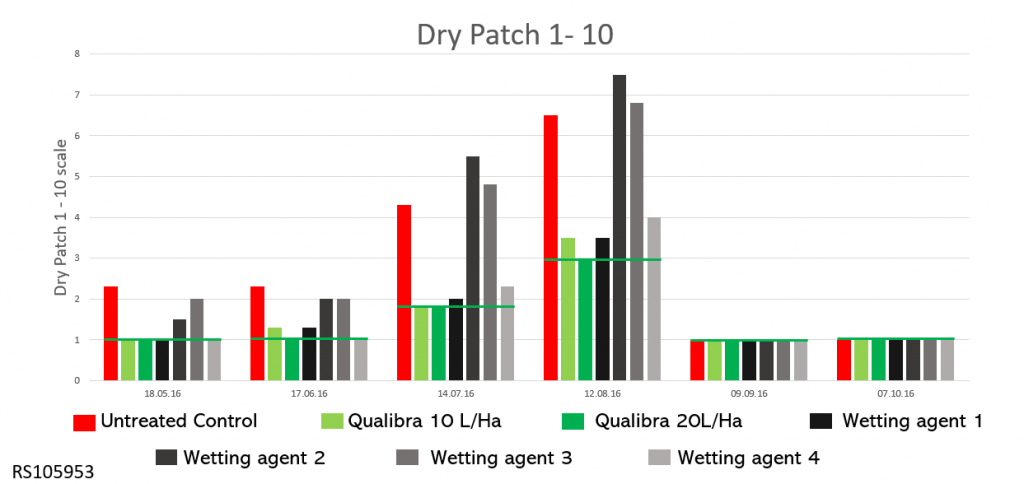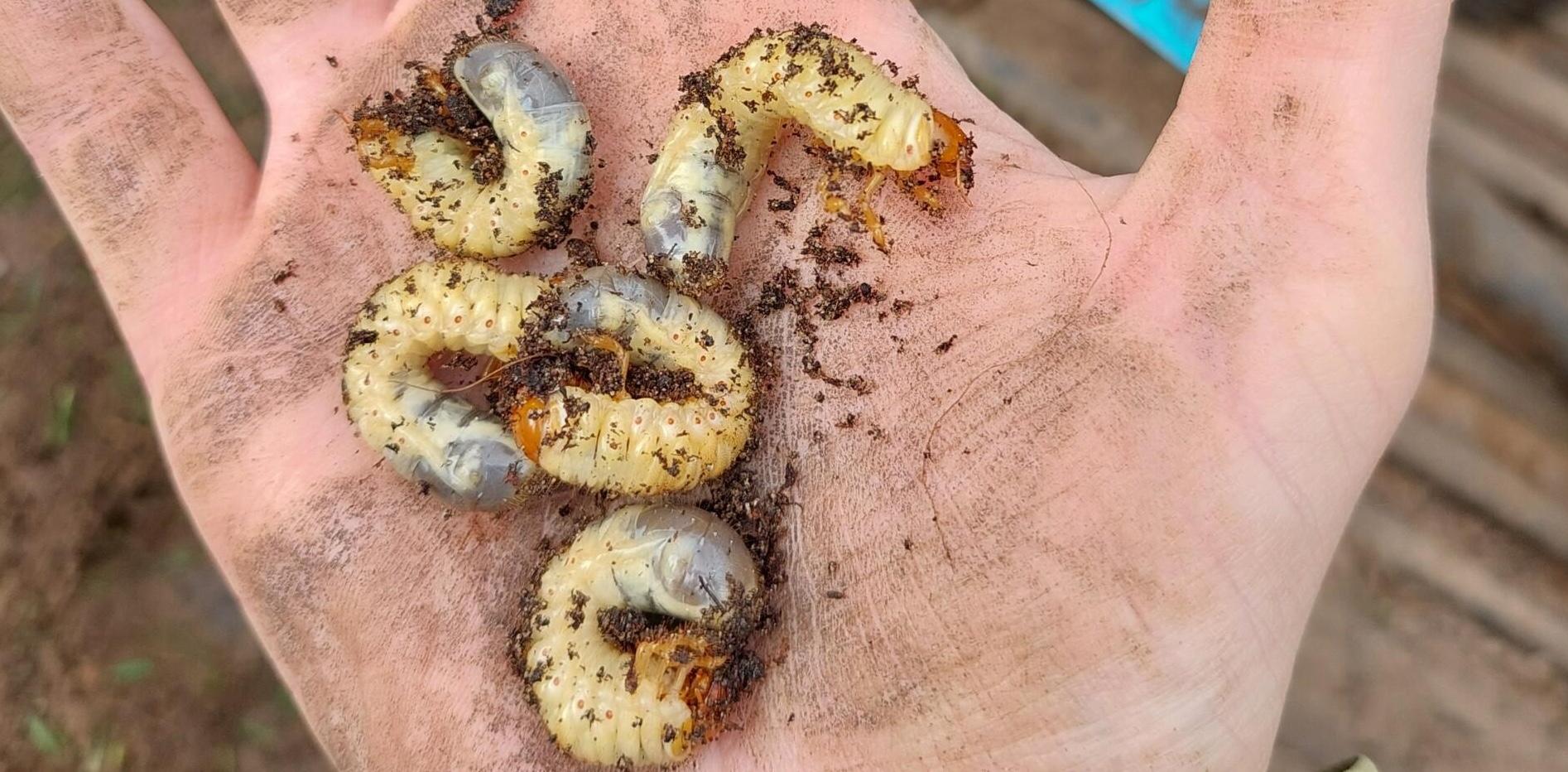March 2021: With parts of the country once again hitting record temperatures and rainfall falling either far too often or not often enough dependent on your location. I thought it would be a good time to pull out some of our research to answer some of my Qualibra FAQ's.

Choosing a wetting agent for your site is a tricky business. We see the value of them in our trials and it's clear that they are not all the same.
When looking to make a decision about which one to use there are some recurring desires and objectives. Rather than talk about the chemistry that goes into Qualibra I thought it would be nice to summarise some of the trial work conducted since 2013. During that period we have conducted a number of studies and included several other products as a comparison.
For consistency I have referred to them as Wetting Agent (number) - if the numbers are the same it is the same product.
When it's dry I want my wetting agent to hold onto moisture.
The below study we did at STRI throughout the 2016 season. We compared a number of products on the market and when possible purposely tried to kept moisture levels around 20% VMC. Qualibra at both 10L/Ha and 20L/Ha consistently performed well and kept us in an optimum position. Over all of our trials we see 20L/ha constantly perform and improves penetration (see later study). It's fair to say that one other product on the market compared favorably.

Summary: Running greens a bit drier? Qualibra helped hold onto moisture when things dried down.
When it's wet I want my wetting agent to let go of moisture
Maybe that's a simplification of the questions / statements we get but the sentiment is correct. When it's wet you don't want to be holding on to excessive moisture. In the same 2016 trial at STRI we saw that holding the moisture content at around 25% - 30% we certainly weren't the driest but we didn't hold on to the most moisture either. I think it would be impossible to achieve both.

Summary: When rootzones are wetter the holding properties of Qualibra seen in the last study DID NOT hold additional moisture in these studies.
I would like the moisture to be evenly distributed throughout the profile.
In this trial back in 2013 we took some soil samples from a very free draining links site and did some work to test the soil profiles. The figures shown are the number of seconds it took for a water droplet to penetrate the soil profile at different depths. If the droplet took more than 60 seconds to penetrate it is simply recorded as 60. I would have been interested to see how long they went on for but that's how the experiment was done.
The lower the number the quicker the soil absorbed the moisture.
This is where we begin to see the advantages of the full rate Qualibra. Whilst it performed very well at 10 L/ha it is at its optimum at it's full rate. Speed to penetrate the soil profile at both 50mm and 100mm were better than the products we compared it too.

Summary: In this study Qualibra at 20L/Ha showed fastest droplet penetration into sandy links soils at 50mm and 100mm depth.
When it's wet I would like my greens to stay firm but when it's dry I don't want them too firm.
This is a tricky thing achieve. A study we did in 2015 showed that a programmed approach using Qualibra can help to maintain greens that don't get overly firm during dry periods yet when the moisture content is higher additional moisture isn't retained.

Summary: When greens were dry using Qualibra stopped them getting excessively firm, when greens were wetter greens remained as firm as all other treatments.
This is important as we go further into these summers that can throw extremes of weather at us. Prolonged periods of drought, then 35 C temperature followed by heavy rain - yet consistency of surfaces is the objective.
We replicated this study in 2016 and saw a very similar pattern.

Summary: During a dry period when greens are holding low moisture %'s clegg readings remained consistently reduced from the untreated control.
Are there any benefits beyond moisture control?
Keeping moisture available and allowing the soil profile to re-wet is critical to keeping the plant healthy. Any minor differences will help the plant through difficult periods.
The below image shows some pot trial work we did that showed a clear benefit to germinating seedlings. Having evenly distributed moisture during this period is a key factor in establishment. We'd expect similar results to be seen during the stress periods of the summer.

Summary: The more effectively you hold moisture in the rootzone the more opportunity there is for the plant to establish a healthy root system.
Above all - I don't want to see any dry patch.
In the same 2016 STRI trial we scored the dry patch in each plot and compared. This was the heavily droughted plot that we tried to keep well under 20% VMC.
Once again Qualibra did it's job and returned the lowest assessment scores throughout the trial.

Summary: In this study Qualibra treated plots showed the lowest evidence of dry patch of all the plots.

In summary - There are some great wetting agents out there, Here at Syngenta we commit to research and studying our product both in the trial ground and in the field, we genuinely believe we have the best product in a market where there are a couple of other outstanding products.
However there are some products that are certainly not outstanding and in many of our trials - products returned disappointing results compared to the untreated control.




